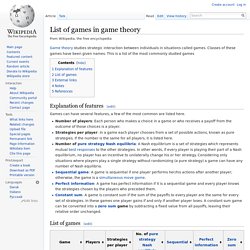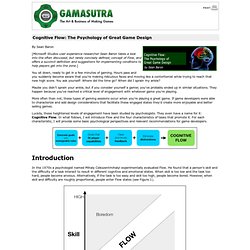

Agence de communication par le jeu - Ma Langue Au Chat. Play Freedom Bridge in your browser. Jeux vidéo PC et consoles - Gamekult. Principe de classification. La classification en ligne du jeu vidéo Ce site vous propose une classification collaborative adaptée au jeu vidéo, qui s'appuie sur plusieurs critères simultanés.

Les jeux vidéo y sont classifiés en regard de leur :Catégorie générale : Une catégorie globale déduite d'après les autres critères.Gameplay : Le titre propose t-il des objectifs à atteindre à l'image d'un "jeu", ou laisse t'il plutôt le joueur libre de ses choix comme tout "jouet" qui se respecte ? Au-delà de ces deux principes généraux, les règles à la base de chaque jeu sont analysés et représentées par des briques de GamePlay.Intention : Au-delà de son aspect ludique, ce titre vise t'il d'autres intentions?
A t'il par exemple pour mission de vous entraîner, de diffuser un message ou encore de raconter une histoire ? Marché : Quels sont les domaines d'application dans lesquels est effectivement utilisé ce jeu ? Catégorie générale Catégories Sous-Catégories Gameplay Eviter Exemples Atteindre Détruire Créer Gérer Déplacer Aléatoire Tirer. Google lance un MMORPG en réalité augmentée à jouer IRL. List of games in game theory. Game theory studies strategic interaction between individuals in situations called games.

Classes of these games have been given names. Tendances. Les principales tendances observées ces dernières années, et qui devraient selon toute vraisemblance se poursuivre, sont le développement des plateformes sociales et mobiles.

Les jeux sociaux représentent ainsi 13% du marché du jeu vidéo (et 36% du jeu en ligne), et leur chiffre d’affaires devrait doubler d’ici 2016 (de 5,4 milliards à 10,7 milliards d’euros). The Gamification of Learning and Instruction: Game-based Methods and ... - Karl M. Kapp. Personality And Play Styles: A Unified Model. Personality And Play Styles: A Unified Model By Bart Stewart [In this comprehensive analysis, multiple psychological systems of gameplay are surveyed, to try and arrive at a unified model in which player behavior can be understood and, crucially for game developers, catered to.]

Numerous models of gamer psychology have been proposed and debated over the past couple of decades. One of the earliest and simplest has proven to be one of the most referenced and most enduring: the Bartle Types. I believe this is because the Bartle Types are a functional model of human personality in a game playing context. In fact, several of the best-known play style and game design models share many conceptual elements.
(Please note that any and all references I make in this article to the works of Richard Bartle, David Keirsey, Christopher Bateman and others that aren't clearly sourced as quotations are my own interpretations. The Bartle Types The Keirsey Temperaments (Stewart Format) (click for full size) 1. Games for Change. Jane McGonigal: Gaming can make a better world. I'm Jane McGonigal.

I'm a game designer.I've been making games online now for 10 years,and my goal for the next decadeis to try to make it as easy to save the world in real lifeas it is to save the world in online games.Now, I have a plan for this,and it entails convincing more people,including all of you, to spend more time playing bigger and better games. Right now we spend three billion hours a week playing online games.Some of you might be thinking,"That's a lot of time to spend playing games.Maybe too much time,considering how many urgent problems we have to solve in the real world.
"But actually, according to my research at the Institute for the Future,actually the opposite is true.Three billion hours a week is not nearly enough game playto solve the world's most urgent problems. Here's why.This picture pretty much sums up why I think games are so essentialto the future survival of the human species. Gamification. About the Course Gamification is the application of digital game design techniques to non-game contexts, such as business, education, and social impact challenges.

Video games are the dominant entertainment form of modern times because they powerfully motivate behavior. Game mechanics can be applied outside the immersive environments of games themselves, to create engaging experiences as well as assign rewards and recognition. Over the past few years, gamification adoption has skyrocketed.
Companies use game thinking for employee motivation in human resources, team building, productivity enhancement, training, health and wellness, sustainability, and innovation. Game thinking means more than dropping in badges and leaderboards to make an activity fun or addicting. Subtitles forall video lectures available in: English, Russian (provided by Digital October), Turkish (Koc University), and Ukrainian (provided by Bionic University) Course Syllabus The course is divided into 12 units. 1. 2. Cognitive Flow: The Psychology of Great Game Design. Cognitive Flow: The Psychology of Great Game Design By Sean Baron [Microsoft Studios user experience researcher Sean Baron takes a look into the often discussed, but rarely concisely defined, concept of Flow, and offers a succinct definition and suggestions for implementing conditions to help players get into the zone.]

You sit down, ready to get in a few minutes of gaming.